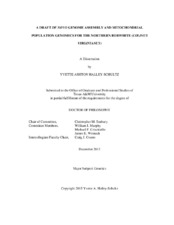| dc.description.abstract | Wild populations of northern bobwhites (Colinus virginianus; hereafter bobwhite) have declined across most of their historic U.S. range, and despite their importance as an experimental wildlife model for ecotoxicology studies, no bobwhite draft genome assembly has emerged. Herein, we present the first bobwhite draft de novo genome assembly, with more than 90% of the assembled bobwhite genome captured within < 40,000 final scaffolds (N50 = 45.4 Kb) despite evidence for approximately 3.22 heterozygous polymorphisms per Kb. Moreover, three annotation analyses produced evidence for > 14,000 unique genes and proteins. Bobwhite analyses of divergence with the chicken (Gallus gallus) and zebra finch (Taeniopygia guttata) genomes revealed many extremely conserved gene sequences, and evidence for lineage-specific divergence of noncoding regions. Coalescent models for reconstructing the demographic history of the bobwhite and the scarlet macaw were concordant with how opposing natural selection strategies (i.e., skewness in the r-/K-selection continuum) would be expected to shape genome diversity and the effective population sizes in these species.
Using genomic tools and resources developed via the draft genome assembly, we evaluated the concordance of population inferences and conclusions resulting from the analysis of short mitochondrial fragments (i.e., partial or complete D-Loop nucleotide sequences) versus complete mitogenome sequences for 53 bobwhites representing six ecoregions across TX and OK (USA). Median joining (MJ) haplotype networks demonstrated that analyses performed using small mitochondrial fragments were insufficient for estimating the true (i.e., complete) mitogenome haplotype structure, corresponding levels of divergence, and maternal population history of our samples. Notably, discordant demographic inferences were observed when mismatch distributions of partial (i.e., partial D-Loop) versus complete mitogenome sequences were compared, with the reduction in mitochondrial genomic information content observed to encourage spurious inferences in our samples. A probabilistic approach to variant prediction for the complete bobwhite mitogenomes revealed 344 segregating sites corresponding to 347 total mutations, including 49 putative nonsynonymous single nucleotide variants (SNVs) distributed across 12 protein coding genes. Evidence of gross heteroplasmy was observed for 13 bobwhites, with 10 of the 13 heteroplasmies involving one moderate to high frequency SNV. Haplotype network and phylogenetic analyses for the complete bobwhite mitogenome sequences revealed two divergent maternal lineages (dXY = 0.00731; FST = 0.849; P < 0.05), thereby supporting the potential for two putative subspecies. However, the diverged lineage (n = 103 variants) almost exclusively involved bobwhites geographically classified as Colinus virginianus texanus, which is discordant with the expectations of previous geographic subspecies designations. Tests of adaptive evolution for functional divergence (MKT), frequency distribution tests (D, FS) and phylogenetic analyses (RAxML) provide no evidence for positive selection or hybridization with the sympatric scaled quail (Callipepla squamata) as being explanatory factors for the two bobwhite maternal lineages observed. Instead, our analyses support the supposition that two diverged maternal lineages have survived from pre-expansion to post-expansion population(s), with the segregation of some slightly deleterious nonsynonymous mutations. | en |


